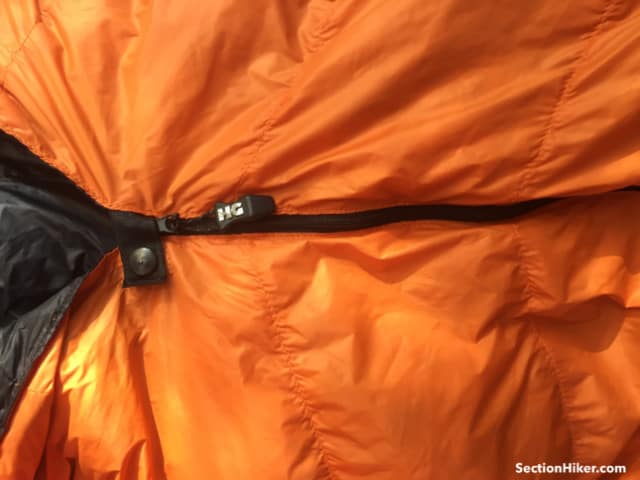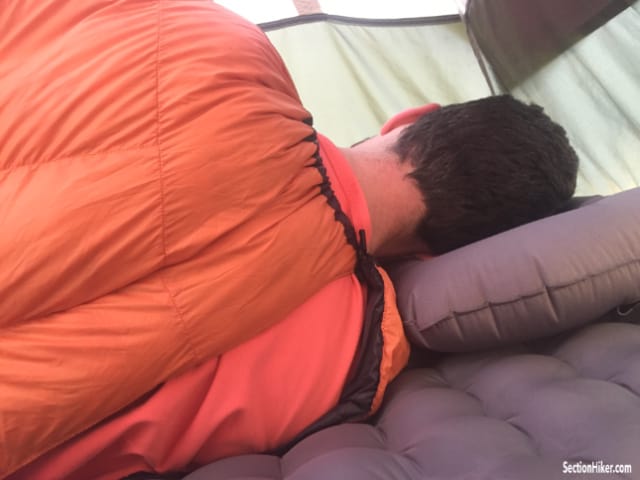The Hammock Gear Economy Burrow Quilt (“Econ Burrow”) is a fantastic value for a high-quality top quilt and perfectly suited as a hammock top quilt for the backpacker who doesn’t mind a few extra ounces in exchange for a much lower price. The Econ Burrow works on the ground, too, although it takes a while to get used to the mitten hooks connecting the quilt to the attachment system. For cold temperatures closer to the quilts 20-degree limit, you may find it simpler to use a lightweight bivy sack or sleeping bag cover for draft protection.
Specs at a Glance
These are the specs for the quilt we tested; see below for a list of the many options available for this quilt
- Temperature Rating: 30* F
- Shape: Half taper
- Length: Standard model (74 inches)
- Shoulder width: Wide model (55 inches, the option for ground and hammock use)
- Foot width: 40 inches (unzipped)
- Footbox style: Cinch end, with zippered footbox
- Fabric: 20 denier nylon taffeta, orange outside, black inside
- Overfill: None
- Included accessories: Large cotton storage sack, small nylon stuff sack, ground pad attachment kit
- Fill Weight: 12.78 ounces
- Total Weight: 22.08 ounces stated, 23.8 ounces measured
Lots of Customizable Options (see Hammock Gear’s site for complete options)
- Temperature rating: 40, 30, 20, 10 or 0*F
- Shape: Half taper
- Length: Short, Standard, or Long
- Width: 50” for hammocks or 55” for ground or hammocks
- Footbox style: sewn or cinch
- Inside and outside color choices
- Overfill amount (up to 4 ounces)
- Include ground pad attachment kit (yes/no)
Hammock Gear Economy Burrow Quilt
Weight
Insulation Value
Shell and Liner
Pad Attachment System
Quality
Availability
Footbox Style
When ordering from Hammock Gear, you can select your preferred footbox style—sewn or cinch. A sewn footbox is simpler and warmer, and a better option for the colder end of the spectrum. Hammock Gear concurs and recommends the sewn end for quilts 20*F and lower. The cinch end footbox can be loosened and unzipped to create a completely flat, comforter-style quilt, allowing it to be more comfortably used over a wider temperature range (i.e. warmer than rated). The top of the zipper is reinforced with a robust snap. This takes the pressure off the zipper and prevents it from being ripped open by your movement in the night.

The cinch end on the Econ Burrow leaves a small gap that allows heat to escape, even when fully tightened. You can stuff extra clothing to plug the gap, but if you are traveling ultralight you may not have clothing to spare except for wet and dirty socks! I made a small 2”x4” rectangular plug out of leftover synthetic insulation (polyester batting would work fine) encased in some lightweight scrap fabric. If I’m taking a cinch end quilt on a trip where it won’t get warm enough to need to vent, I just leave the plug in the whole time so it doesn’t get lost.

Down Insulation
The Econ Burrow uses 800 fill power DWR Duck down while Hammock Gear’s Premium Quilts are available with 850 or 950 fill power DWR Goose down. Both kinds of down are RDS-certified which means they are responsibly-sourced, not taken from birds that are force-fed or live-plucked, and they are DWR (Durable Water Repellant) treated to reduce down’s susceptibility to moisture collapse. Duck down comes in a lower fill power than Hammock Gear’s Goose down quilts and is less expensive, but is just as warm as goose down of the same fill power. I noticed no smell to the down in the Econ quilt. The 30* quilt was well-stuffed and cozy.
Fabrics
The Econ Burrow uses 20 denier, 1.1 oz/ sq. yd. calendared nylon taffeta with DWR while Hammock Gear’s Premium Quilts are available with 10 denier 0.67 oz/ sq. yd. calendared nylon taffeta (inner) and ripstop (outer) with DWR. While I’ve heard the Premium line has a nicer fabric feel, the fabric on the Econ feels soft and supple, not stiff and plasticky like some budget nylon sleeping bags.

Baffles
The Burrow is a box-baffled quilt (not sewn-through) with vertical baffles over the majority of the body and horizontal baffles at the footbox and neck, to keep the down from shifting downward (toward your sides) overnight and leaving cold spots on top of you. This design is seen on many premium quilts/ bags.

Ground Attachment System
Hammock Gear has upgraded its ground pad attachment system to use wafer clips and webbing straps, like those offered by other premium quilt manufacturers. They work with all sleeping pads but are particularly effective when used with baffled air pads. They’re very easy to configure on your pad and easy to use at night when you’re groggy. If you ever lose the attachment system, you can purchase an inexpensive replacement from Hammock Gear ($2.99 at the time of this article).

Neck Cinch
To seal in warmth around your neck, the Burrow has a neck snap and shockcord with a mini cordlock that adjusts in the center of the quilt. The placement of the cordlock is optimized for back sleepers, where it would be below the chin; it becomes hard to access if you are on your stomach or side on the ground. The shockcord is located at the very end of the quilt, so as you tighten it up, you feel the cord against your neck, but there is “give” as the shockcord is elastic. There is no draft collar (an extra baffle beyond the neck drawcord to seal in warmth and cushion your neck from the cord) on the Burrow.

Use in a hammock
As you might have guessed from the name, Hammock Gear’s niche is with hammocks. The issues that I found on the ground were non-existent in a hammock, where the Econ Burrow excelled. For example, while the neck adjustment was hard for me to access on the ground as a side/stomach sleeper, in a hammock, where I tend to be on my back or slightly turned to the side, I found the placement of the cordlock to be ideal. Although I had the wide version for ground use, and Hammock Gear offers one 5 inches skinnier for hammock users, I appreciated wrapping up in the wide version, even though I have a slight build–it gives you a little extra insurance on chillier nights.
Recommendation
Quality backpacking quilts are usually expensive, but Hammock Gear has found a way to use their premium construction techniques with lower-cost but still high-quality materials to make a quilt that performs well above its price point. Often, budget quilts are a placeholder until one can afford a better option, but the Econ line will provide long-lasting value to all but the most ultralight ounce-counters. I found the Econ Burrow to be well-made, comfortable, warm, soft, and compressible.
We recommend the Econ Burrow as an excellent hammock top quilt option. In colder temperatures, we recommend the sewn-end over the cinched end. We also suggest using a bivy sack for draft protection below 20-30 degrees.
About the author
Disclosure: Hammock Gear provided SectionHiker with a quilt for this review.
SectionHiker is reader-supported. We only make money if you purchase a product through our affiliate links. Help us continue to test and write unsponsored and independent gear reviews, beginner FAQs, and free hiking guides. SectionHiker.com Backpacking Gear Reviews and FAQs
SectionHiker.com Backpacking Gear Reviews and FAQs 
I think a neck draft collar is an option missing for a lot of manufacturers unfortunately. Nice looking quilt otherwise!
Perfectly understandable for an economy quilt though. If you want features, you have to go custom.
Take a piece of non-elastic cord and tie on two prusiks. Make the loops as short as possible (I use a hemostat to get the last few wraps). Attach the mitten hooks to the loops and attach the whole mess to the quilt. In the field, attach the cord to the pad, you can either tie directly or use a toggle. Adjust the prusiks and you’re in business, no slipping. I find with my Premium Burrow I only need one cord that I attach to the gross grain loops just under my butt.
Or hammock gear could fix their system so you wouldn’t have to DIY
I have a 20°F with 2oz overfill. I’ve had it in the teens overnight in snow and it performed perfectly. The only thing I changed was the pad stap system. I bought the UG pad straps because they have the toggles rather than the clips. I had to put small loops of bungee on the fabric loops to accomodate the toggles. Works great. Agree with the writer about the footbox draft. This by no means is a low quality or “starter” quilt. It is well made, they have great service, and the price point as compared to EE is a no brainer. Good quality doesn’t equal an outrageous price.
I love that suggestion, Rex. Thanks for sharing your experience. Prusiks are also the way Cedar Ridge Outdoors does their pad attachment for their quilts. Prusiks are infinitely useful; I recommended their use on the Kammok Pongo Pad and Puffin Pillow review here to lock them onto a hammock ridgeline. Knots (and hitches) to the rescue!
I have been using my 20d Econ for a year now. So far I have had it down into the lower 30s and have been toasty warm. I couldn’t be more pleased with the quality construction and great features.
Got a good chuckle out of your description of being a “rotisserie” sleeper. That is exactly the phrase that describes my own sleep habit. Enjoyed reading this review, as always, and of course, what others have to say. Keep ’em coming. Thx.
I own three of these and they are fantastic! My kids and I use them and are always warm. I can certify the 30 degree quilt worked for me down to 30 on a lightly windy night cowboy camping in NM. Great quality, at a nice price.
Thom, thanks, your comment made me feel more confident of my purchase. I haven’t received it yet, but am very much looking forward to some late fall camping here in Southern Ontario. I’ve got a Thermarest Corus 30 degree quilt & it works as good as expected, so I’m expecting great things!!!!
Jim
Nice review, Greg.
Great detail.
One question. You say you have a “slight build” yet the nick cinch picture makes the Burrow look maybe too narrow for you. How do you feel about the width for ground use? I was considering a Burrow but other vendors offer wider options, UGQ, EE etc..I am 6’3” 230lbs so I worry about width if I toss and turn.
Thanks!
Thanks, Andrew. I think what you’re seeing is that when I turned on my side for the picture, the side closest to the ground drooped away due to gravity, so it looks like the coverage is more limited than it is. What I recommend if you are concerned about size is to get a piece of scrap fabric (cheap curtain or sheet from a thrift store, washed of course, or the bargain bin at a sewing/craft store) and cut it to the dimensions of the quilt. You can duct tape a channel in the foot end (or use the curtain rod channel) that you can run a shoelace through to cinch up the end. Then lie down and toss and turn and see if it’s sufficient or if you’re having to tug at it for coverage. Personally, I don’t like having to rely on straps for coverage–I like my quilts to be wide enough to tuck around me.